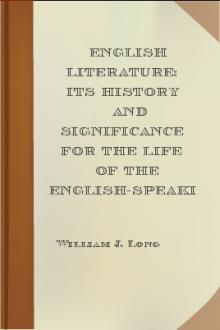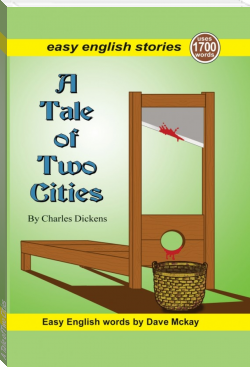English Literature: Its History and Significance for the Life of the English-Speaking World by William J. Long (good books for 8th graders txt) 📕

- Author: William J. Long
- Performer: -
Book online «English Literature: Its History and Significance for the Life of the English-Speaking World by William J. Long (good books for 8th graders txt) 📕». Author William J. Long
Charles Reade. In his fondness for stage effects, for picturing the romantic side of common life, and for using the novel as the instrument of social reform, there is a strong suggestion of Dickens in the work of Charles Reade (1814-1884). Thus his Peg Woffington is a study of stage life from behind the scenes; A Terrible Temptation is a study of social reforms and reformers; and Put yourself in his Place is the picture of a workingman who struggles against the injustice of the trades unions. His masterpiece, The Cloister and the Hearth (1861), one of our best historical novels, is a somewhat laborious study of student and vagabond life in Europe in the days of the German Renaissance. It has small resemblance to George Eliot's Romola, whose scene is laid in Italy during the same period; but the two works may well be read in succession, as the efforts of two very different novelists of the same period to restore the life of an age long past.
Anthony Trollope. In his realism, and especially in his conception of the novel as the entertainment of an idle hour, Trollope (1815-1882) is a reflection of Thackeray. It would be hard to find a better duplicate of Becky Sharp, the heroine of Vanity Fair, for instance, than is found in Lizzie Eustace, the heroine of The Eustace Diamonds. Trollope was the most industrious and systematic of modern novelists, writing a definite amount each day, and the wide range of his characters suggests the Human Comedy of Balzac. His masterpiece is Barchester Towers (1857). This is a study of life in a cathedral town, and is remarkable for its minute pictures of bishops and clergymen, with their families and dependents. It would be well to read this novel in connection with The Warden (1855), The Last Chronicle of Barset (1867), and other novels of the same series, since the scenes and characters are the same in all these books, and they are undoubtedly the best expression of the author's genius. Hawthorne says of his novels: "They precisely suit my taste,--solid and substantial, and ... just as real as if some giant had hewn a great lump out of the earth and put it under a glass case, with all the inhabitants going about their daily business and not suspecting that they were being made a show of."
Charlotte Brontë. We have another suggestion of Thackeray in the work of Charlotte Brontë (1816-1855). She aimed to make her novels a realistic picture of society, but she added to Thackeray's realism the element of passionate and somewhat unbalanced romanticism. The latter element was partly the expression of Miss Brontë's own nature, and partly the result of her lonely and grief-stricken life, which was darkened by a succession of family tragedies. It will help us to understand her work if we remember that both Charlotte Brontë and her sister Emily[242] turned to literature because they found their work as governess and teacher unendurable, and sought to relieve the loneliness and sadness of their own lot by creating a new world of the imagination. In this new world, however, the sadness of the old remains, and all the Brontë novels have behind them an aching heart. Charlotte Brontë's best known work is Jane Eyre (1847), which, with all its faults, is a powerful and fascinating study of elemental love and hate, reminding us vaguely of one of Marlowe's tragedies. This work won instant favor with the public, and the author was placed in the front rank of living novelists. Aside from its value as a novel, it is interesting, in many of its early passages, as the reflection of the author's own life and experience. Shirley (1849) and Villette (1853) make up the trio of novels by which this gifted woman is generally remembered.
Bulwer Lytton. Edward Bulwer Lytton (1803-1873) was an extremely versatile writer, who tried almost every kind of novel known to the nineteenth century. In his early life he wrote poems and dramas, under the influence of Byron; but his first notable work, Pelham (1828), one of the best of his novels, was a kind of burlesque on the Byronic type of gentleman. As a study of contemporary manners in high society, Pelham has a suggestion of Thackeray, and the resemblance is more noticeable in other novels of the same type, such as Ernest Maltravers (1837), The Caxtons (1848-1849), My Novel (1853), and Kenelm Chillingly (1873). We have a suggestion of Dickens in at least two of Lytton's novels, Paul Clifford and Eugene Aram, the heroes of which are criminals, pictured as the victims rather than as the oppressors of society. Lytton essayed also, with considerable popular success, the romantic novel in The Pilgrims of the Rhine and Zanoni, and tried the ghost story in The Haunted and the Haunters. His fame at the present day rests largely upon his historical novels, in imitation of Walter Scott, The Last Days of Pompeii (1834), Riettza (1835), and Harold (1848), the last being his most ambitious attempt to make the novel the supplement of history. In all his novels Lytton is inclined to sentimentalism and sensationalism, and his works, though generally interesting, seem hardly worthy of a high place in the history of fiction.
Kingsley. Entirely different in spirit are the novels of the scholarly clergyman, Charles Kingsley (1819-1875). His works naturally divide themselves into three classes. In the first are his social studies and problem novels, such as Alton Locke (1850), having for its hero a London tailor and poet, and Yeast (1848), which deals with the problem of the agricultural laborer. In the second class are his historical novels, Hereward the Wake, Hypatia, and Westward Ho! Hypatia is a dramatic story of Christianity in contact with paganism, having its scene laid in Alexandria at the beginning of the fifth century. Westward Ho! (1855), his best known work, is a stirring tale of English conquest by land and sea in the days of Elizabeth. In the third class are his various miscellaneous works, not the least of which is Water-Babies, a fascinating story of a chimney sweep, which mothers read to their children at bedtime,--to the great delight of the round-eyed little listeners under the counterpane.
Mrs. Gaskell. Mrs. Elizabeth Gaskell (1810-1865) began, like Kingsley, with the idea of making the novel the instrument of social reform. As the wife of a clergyman in Manchester, she had come in close contact with the struggles and ideals of the industrial poor of a great city, and she reflected her sympathy as well as her observation in Mary Barton (1848) and in North and South (1855). Between these two problem novels she published her masterpiece, Cranford, in 1853. The original of this country village, which is given over to spinsters, is undoubtedly Knutsford, in Cheshire, where Mrs. Gaskell had spent her childhood. The sympathy, the keen observation, and the gentle humor with which the small affairs of a country village are described make Cranford one of the most delightful stories in the English language. We are indebted to Mrs. Gaskell also for the Life of Charlotte Brontë, which is one of our best biographies.
Blackmore. Richard Doddridge Blackrhore (1825--1900) was a prolific writer, but he owes his fame almost entirely to one splendid novel, Lorna Doone, which was published in 1869. The scene of this fascinating romance is laid in Exmoor in the seventeenth century. The story abounds in romantic scenes and incidents; its descriptions of natural scenery are unsurpassed; the rhythmic language is at times almost equal to poetry; and the whole tone of the book is wholesome and refreshing. Altogether it would be hard to find a more delightful romance in any language, and it well deserves the place it has won as one of the classics of our literature. Other works of Blackmore which will repay the reader are Clara Vaughan (1864), his first novel, The Maid of Sker (1872), Springhaven (1887), Perlycross (1894), and Tales from the Telling House (1896); but none of these, though he counted them his best work, has met with the same favor as Lorna Doone.
Meredith. So much does George Meredith (1828-1909) belong to our own day that it is difficult to think of him as one of the Victorian novelists. His first notable work, The Ordeal of Richard Feverel, was published in 1859, the same year as George Eliot's Adam Bede; but it was not till the publication of Diana of the Crossways in 1885, that his power as a novelist was widely recognized. He resembles Browning not only in his condensed style, packed with thought, but also in this respect,--that he labored for years in obscurity, and after much of his best work was published and apparently forgotten he slowly won the leading place in English fiction. We are still too near him to speak of the permanence of his work, but a casual reading of any of his novels suggests a comparison and a contrast with George Eliot. Like her, he is a realist and a psychologist; but while George Eliot uses tragedy to teach a moral lesson, Meredith depends more upon comedy, making vice not terrible but ridiculous. For the hero or heroine of her novel George Eliot invariably takes an individual, and shows in each one the play of universal moral forces. Meredith constructs a type-man as a hero, and makes this type express his purpose and meaning. So his characters seldom speak naturally, as George Eliot's do; they are more like Browning's characters in packing a whole paragraph into a single sentence or an exclamation. On account of his enigmatic style and his psychology, Meredith will never be popular; but by thoughtful men and women he will probably be ranked among our greatest writers of fiction. The simplest and easiest of his novels for a beginner is The Adventures of Henry Richmond (1871). Among the best of his works, besides the two mentioned above, are Beauchamp's Career (1876) and The Egoist (1879). The latter is, in our personal judgment, one of the strongest and most convincing novels of the Victorian Age.
Hardy. Thomas Hardy (1840-) seems, like Meredith, to belong to the present rather than to a past age, and an interesting comparison may be drawn between these two novelists. In style, Meredith is obscure and difficult, while Hardy is direct and simple, aiming at realism in all things. Meredith makes man the most important phenomenon in the universe; and the struggles of men are brightened by the hope of victory. Hardy makes man an insignificant part of the world, struggling against powers greater than himself,--sometimes against systems which he cannot reach or influence, sometimes against a kind of grim world-spirit who delights in making human affairs go wrong. He is, therefore, hardly a realist, but rather a man blinded by pessimism; and his novels, though generally powerful and sometimes fascinating, are not pleasant or wholesome reading. From the reader's view point some of his earlier works, like the idyllic love story Under the Greenwood Tree (1872) and A Pair of Blue





Comments (0)